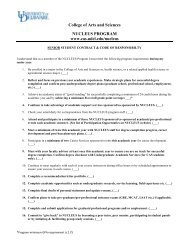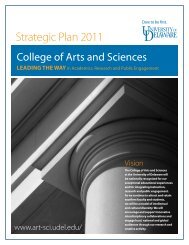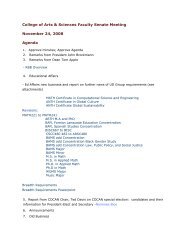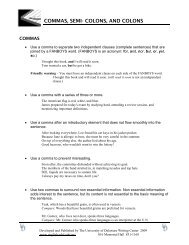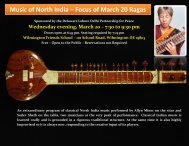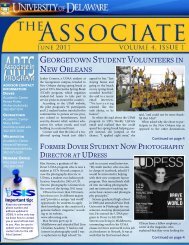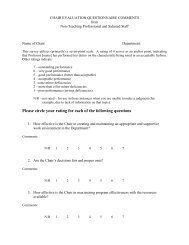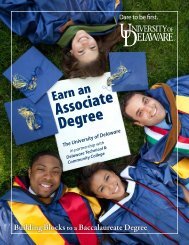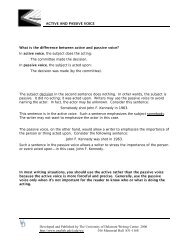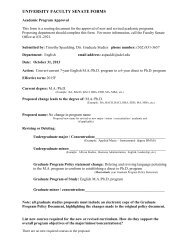Modeling with Mathematics John A. Pelesko and Michelle Cirillo ...
Modeling with Mathematics John A. Pelesko and Michelle Cirillo ...
Modeling with Mathematics John A. Pelesko and Michelle Cirillo ...
You also want an ePaper? Increase the reach of your titles
YUMPU automatically turns print PDFs into web optimized ePapers that Google loves.
<strong>Modeling</strong> <strong>with</strong> <strong>Mathematics</strong><strong>John</strong> A. <strong>Pelesko</strong> <strong>and</strong> <strong>Michelle</strong> <strong>Cirillo</strong>Department of Mathematical Sciences, University of DelawareOver ten years ago, the National Council of Teachers of <strong>Mathematics</strong> included modelingas an important element of their Algebra, Geometry, <strong>and</strong> Representation st<strong>and</strong>ards in the (2000)Principles <strong>and</strong> St<strong>and</strong>ards for School <strong>Mathematics</strong>. The authors recommended that students in allgrades use mathematical models to represent <strong>and</strong> underst<strong>and</strong> quantitative relationships, to solvegeometric problems, <strong>and</strong> to interpret physical, social, <strong>and</strong> mathematical phenomena (NCTM,1990). <strong>Modeling</strong> has been incorporated even more prevalently into the Common Core StateSt<strong>and</strong>ards in <strong>Mathematics</strong> (CCSS-M; National Governors Association Center for Best Practices& Council of Chief State School Officers, 2010) <strong>with</strong> modeling being both one of the eightSt<strong>and</strong>ards for Mathematical Practice as well as an important content st<strong>and</strong>ard at every grade levelfrom Kindergarten through High School. Using modeling, mathematically proficient studentsshould be able to “apply the mathematics they know to solve problems arising in everyday life,society, <strong>and</strong> the workplace” (p. 7). More specifically, the document states:Mathematically proficient students who can apply what they know are comfortablemaking assumptions <strong>and</strong> approximations to simplify a complicated situation, realizingthat these may need revision later. They are able to identify important quantities in apractical situation <strong>and</strong> map their relationships using such tools as diagrams, two-waytables, graphs, flowcharts, <strong>and</strong> formulas. They can analyze those relationshipsmathematically to draw conclusions. They routinely interpret their mathematical resultsin the context of the situation <strong>and</strong> they reflect on whether the results make sense, possiblyimproving the model if it has not served its purpose. (p. 7)The ability to model <strong>with</strong> mathematics is considered a practice that mathematics educatorsshould seek to develop in their students. As teachers, we need to support our students indeveloping the Model <strong>with</strong> <strong>Mathematics</strong> practice, one of the eight practices which rest onimportant processes <strong>and</strong> proficiencies <strong>with</strong> longst<strong>and</strong>ing importance in mathematics education(CCSS-M, 2010).In this seminar, we take a “h<strong>and</strong>s-on” approach to the subject of mathematical modeling. Thegoal is to engage participants in the entire process: observation, experiment, construction of amodel, analysis of a model, <strong>and</strong> connecting mathematical underst<strong>and</strong>ing <strong>with</strong> underst<strong>and</strong>ing ofthe natural world. Participants will make use of our experimental laboratory, the MEC Lab, <strong>and</strong>carry out simple experiments, gather data, <strong>and</strong> build models. Computational investigations ofmathematical models will also occur, using such tools as Maple, Mathematica, GeometersSketchpad, <strong>and</strong> Matlab.During the seminar, our focus will be on how mathematics can be used as a way ofunderst<strong>and</strong>ing the natural world. Mathematically, our tools will range from sequences of naturalnumbers, to systems of equations, functions, <strong>and</strong> elements of calculus. Fellows at all levels arewelcome <strong>and</strong> encouraged to join this seminar. Each Fellow will be encouraged to develop h<strong>and</strong>sonactivities that can be taken back to the classroom <strong>and</strong> used to teach mathematical modeling.
Fellows who are not mathematics teachers, but who teach science at any level, are also welcome<strong>and</strong> encouraged to join this seminar. Such Fellows will be encouraged to take current scienceclassroom activities <strong>and</strong> integrate mathematics into them.ReferencesNational Council of Teachers of <strong>Mathematics</strong>. (2000). Principles <strong>and</strong> st<strong>and</strong>ards for schoolmathematics. Reston, VA: Author.National Governors Association Center for Best Practices & Council of Chief State SchoolOfficers. (2010). Common core state st<strong>and</strong>ards for mathematics. Retrieved fromCommon Core State St<strong>and</strong>ards website: http://www.corest<strong>and</strong>ards.org/thest<strong>and</strong>ards/mathematics



